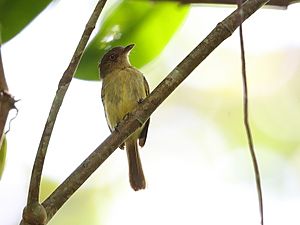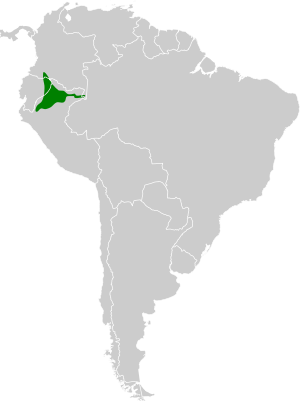Orange-eyed flatbill facts for kids
Quick facts for kids Orange-eyed flatbill |
|
|---|---|
 |
|
| Conservation status | |
| Scientific classification | |
| Genus: |
Tolmomyias
|
| Species: |
traylori
|
 |
|
The orange-eyed flatbill or orange-eyed flycatcher (Tolmomyias traylori) is a small bird that lives in the Amazon rainforest. It belongs to the Tyrannidae family, which includes many types of flycatchers. You can find this bird in parts of south-eastern Colombia, eastern Ecuador, and north-eastern Peru.
Scientists first realized this was a unique species because of its special voice. It was officially described in 1997. The bird's scientific name honors an American bird expert named Melvin Alvah Traylor Jr.. The International Union for Conservation of Nature says this bird is of "least concern", meaning it's not currently in danger of disappearing.
Contents
What Does It Look Like?
The orange-eyed flatbill is about 13 cm (5 in) long. Its upper body is olive green, and its head is greyish. The front of its face, throat, and chest are a greyish-buff color. Its belly is yellowish.
A special feature of this bird is its bright orange eyes. This, along with its buff-colored throat, helps tell it apart from other similar birds.
Its Unique Song
The song of the orange-eyed flatbill is a series of five to seven notes that sound like "zhreee". This song is longer and sounds more scratchy than the song of the yellow-breasted flatbill. It can be hard to tell different flatbill species apart just by looking at them. Their songs are often the easiest way to identify them!
Where It Lives and What It Likes
The orange-eyed flatbill lives in the northwestern part of the Amazon. Its home stretches from southeastern Colombia, through eastern Ecuador, and into northeastern Peru. It seems to take the place of the yellow-olive flatbill in areas north of the Amazon River. You can also find it on large islands in the river.
This bird prefers to live in the middle part of tall, seasonally-flooded forests. These are forests that get flooded at certain times of the year. The orange-eyed flatbill is usually seen alone or in pairs. It doesn't often join large groups of different bird species.
Its Nest
Like other birds in its group, the orange-eyed flatbill builds a unique nest. It's shaped like a bag with a tube-like entrance near the bottom. These nests are often hung close to a wasp nest. This might help protect the bird's eggs and chicks from predators.
Conservation Status
The orange-eyed flatbill lives across a very large area in the western Amazon. It's not a super common bird, but it's not extremely rare either. We don't know exactly if its numbers are going up or down. However, it's likely that its population is shrinking because of deforestation (when forests are cut down) in its habitat.
Even with this decline, the number of birds is not dropping fast enough to be considered "vulnerable" (at risk of extinction). Because of this, the International Union for Conservation of Nature has listed the orange-eyed flatbill as a "least-concern species". This means that for now, scientists are not too worried about it disappearing.
See also
 In Spanish: Picoplano ojinaranja para niños
In Spanish: Picoplano ojinaranja para niños


